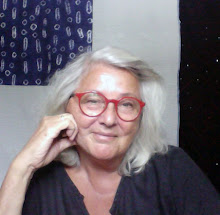 Last Days Before Dying, 2007, acrylic, ink,embroidery, hand made paper
Last Days Before Dying, 2007, acrylic, ink,embroidery, hand made paperPatti Roberts Pizzuto uses an earthy combination of acrylic, embroidery stitches and hand made paper to create poetic works that ponder the big questions about life's meaning. All images in this post are from an article about the artist by Lynn Cornelius Jablonski I found in Fiberarts, April May 2008.
 Waiting Vessel, 2007, acrylic, collage, beads, embroidery, handmade paper
Waiting Vessel, 2007, acrylic, collage, beads, embroidery, handmade paperHer imagery is empty space in combination with one or two common objects such as a bowl, bed or boat and the texture of hand stitching. The recent work shown in this article had either the form of a primitive house shape or a simple rectangle. For me, the house shape is evocative of our personal longing for the simple quietness of childhood, and I would bet that Patti Roberts Pizzuto has read The Poetics of Space by Gaston Bachelard. The artist says that the house image symbolizes comfort family, sense of self and belonging.
 Finding Home, 2006, acrylic, beeswax, embroidery, handmade paper
Finding Home, 2006, acrylic, beeswax, embroidery, handmade paperThe artist worked in the library of an art and design college in Flordia for 25 years, and it was the art books she handled every day that were her inspiration (and I would guess, her education). A recent move to South Dakota in 2005 changed her palette, and fostered an interest in her own family history and the history of mid Western United States.
 Dance of Chance, 2007, acrylic, ink, collage, beads, handmade paper
Dance of Chance, 2007, acrylic, ink, collage, beads, handmade paperObjects that are from our daily lives act like witnesses in her work. They are like things that occur in our dreams, meaningful and with narrative. She rarely depicts figures, but when she does they wear medieval dress.
 Each Leaf a Universe, Each Night a Dream, 2007, acrylic, embroidery, collage, handmade paper
Each Leaf a Universe, Each Night a Dream, 2007, acrylic, embroidery, collage, handmade paperNatural items like seeds, flowers and leaves occur. The seeds are symbols of possibility, of birth, renwal and even death. She contemplates the sacred and the mundane at the same time. Existential work. Quiet Compositions.
Patti Robertsw Pizzuto has her own web site - you need Adobe flash to view it, and so I was not able to visit it. Still on dial up here on Manitoulin Island, Canada.


















